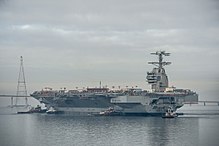Googlailin ydinkäyttöisen lentotukialuksen voimantuottoa. Parilla ydinkäyttöisen
Gerald R. Ford class -tukialuksen voimalalla on sama lämmöntuotto (1400 MW) Kuin olkiluoto kolmosella. Yhden aluksen hinta 13,3 mrd dollaria, on suurinpiirtein sama kuin olkiluoto kolmosella. MItä helvettiä!
A1B reactor
From Wikipedia, the free encyclopedia

In 2013, the aircraft carrier Pre-Commissioning Unit (PCU)
Gerald R. Ford (CVN-78) was moved to Pier 3 at Newport News Shipbuilding for 28 months of additional outfitting and testing.
The
A1B reactor is an
aircraft carrier nuclear reactor developed by the
United States Navy. It is used in
Gerald R. Ford–class aircraft carriers to provide electrical and propulsion energy. The A1B is the first naval reactor produced by
Bechtel Corporation, which has "performed engineering and/or construction services on more than 80 percent of [land-based] nuclear plants in the United States".
[1]
Aircraft carriers' nuclear reactors provide the electrical and motor energy of the ship by splitting
enriched uranium to produce heat and convert water to steam to power steam
turbines. This process is largely the same as in land-based nuclear power stations, the most notable difference being the direct use of turboshaft power for turning the ship's screws. Over decades of development several other design differences have emerged between naval reactors and the usually much larger power station reactors.
As Navy planners developed requirements for the
Gerald R. Ford class, they concluded that the
A4W reactors that provide
propulsion and
electricity for the predecessor
Nimitz-class aircraft carriers offer too little power for contemporary and anticipated future shipboard needs,
[2] so they commissioned a new reactor from Bechtel.
[1]
The new reactor was named A1B, following the Navy's reactor-designation scheme of type, generation, and manufacturer: A for aircraft carrier, 1 for the maker's first reactor plant design, and B for Bechtel.
[3] Two A1B reactor plants will power each
Gerald R. Ford class ship.
It is estimated that the thermal power output of each A1B will be around 700 MWth, some 25% more than provided by the A4W.
[4] Improved efficiency in the total plant is expected to provide improved output to both propulsion and electrical systems. Using A4W data
[5] with a 25% increase in thermal power, the A1B reactors likely produce enough steam to generate 125 megawatts (168,000 hp) of electricity, plus 350,000 shaft horsepower (260 MW) from just one reactor to power the four propeller shafts.
[6]
The increased electrical generation capacity will allow for elimination of service steam on the ship, reducing staffing requirements for maintenance.
[7] Also, the use of
electrical aircraft catapults (EMALS) will free the ship's air wing from reactor plant steam constraints, in comparison to the
steam catapults used for launching aircraft on
Nimitz class carriers, which relied on steam supplied by the nuclear reactor.
The A1B reactor uses modernized technology that is both more advanced and adaptable than previous reactor technology, is smaller and weighs less than the A4W, and has operator interfaces that are expected to be improved as well.


